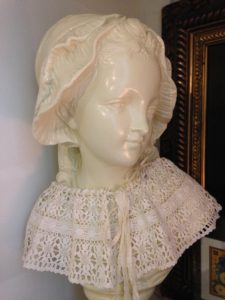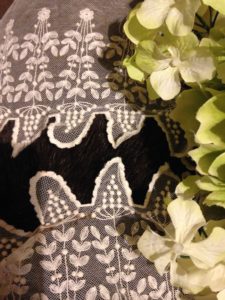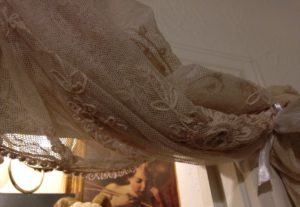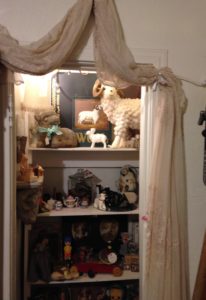Our love affair with lace is hard to hide at Antique Cottage
Lace, the word is derived from Old French “las” in turn from Latin “lacere.” Its origins are wrapped in mystery, for nearly every European country claims to be the first to develop the craft. There are many kinds of lace, and just as many kinds of thread, linen, silk, cotton, synthetic, even spun silver and gold thread have been used.
- Needle lace, as that used in Venetian Gros Point, uses thread and needle, and the oldest samples of this method of lacing used ultra thin delicate thread no longer made anywhere in the world.
- Cutwork, also known as whitework, is lace made by removing parts of the fiber of a piece of fabric to form a pattern and then wrapping the pulled threads or adding embroidery.
- Pillow lace, also known as Bone lace or Bobbin lace, uses threads attached to bobbins and a pillow form. Bobbins made of wood, bone, plastic, keep the various threads separate as they are entwined into patterns laid out on the pillow.
- Macrame and tatting are lacing techniques which employ knot-tying. Tatted lace can be made with a weaving shuttle or with a tatting needle.
- Machine-made lace is any lace made by mechanical methods.
- Chemical lace is made as a continuous pattern of embroidery, and the background material (usually a water soluble or heat-sensitive medium) is dissolved leaving only the embroidery.
- Crocheted lace is made with specially shaped hooked needles (such as Irish, pineapple or filet crochet.) whereas knitted lace uses pairs of long straight needles.
This lovely little American-made crocheted bonnet came from Roundup Texas, it is Edwardian I think.
A nice example of cutwork or whitework lace
Lace, with its multiple methods of production, and too many patterns, styles and materials to count is an absolute passion here at the Cottage. The essential tool was the needle, but the oldest examples of lace were more “cutwork” than woven. The earliest versions of lace making have been attributed to the work of nuns in the convents of central and Southern Europe. Most of their creations were probably adornment for their church altars or the robes of ecclesiastical dignitaries. Barbara Uttman is credited with the invention of pillow lace, which she taught to others from her home; the castle of St. Annaburg, Belgium, in 1561.
By all accounts the true heyday of lace making was the period of history we know as the Renaissance. One method of making lace during that period used threads from a common center as a framework. Over these other threads were gathered in squares, triangles, rosettes and other figures worked over with the buttonhole stitch, forming in some portions openwork, in others solid embroidery. This was, in fact, the first needle-made lace, and doubtless its origin the Venetians. This a beautiful example of netted lace. 
 I bought this in Grayville Illinois from a retiring dealer who had cherished it for years. I had never bought one before and was shocked at how expensive it was. Since then I have come to learn how difficult it is to get a whole bed cover in this condition. We turned it into a scarf around a doorway into our children’s closet.
I bought this in Grayville Illinois from a retiring dealer who had cherished it for years. I had never bought one before and was shocked at how expensive it was. Since then I have come to learn how difficult it is to get a whole bed cover in this condition. We turned it into a scarf around a doorway into our children’s closet.
My absolute favorite lace item is a blouse I got on one of the first French Flea Market Tours we did. There was a wonderful lady in Provence who runs a cottage industry from her home, which is where I bought this gorgeous garment.
I am so in love with lace I have a Pinterest page with almost 2400 pins:
https://www.pinterest.com/lynnimiller/dentille/
If you love lace as much as I do, stop by and check out the beautiful pieces I’ve collected.





